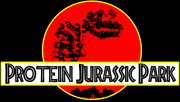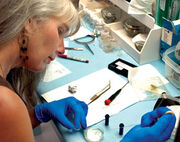
- "And from what? Loy's extractions never recreated an intact DNA strand."
- —Alan Grant(src)
Proteins from dinosaur fossils are used by InGen as a source for the genetic code. The protein code can give a glimpse of what the DNA code looked like. In the novels the subject is only briefly touched upon, and in the films it is never directly mentioned. In both media, DNA in Amber is the main source of genetic material; proteins were only "backup". At the time that the novel was written, the presence of proteins in fossils was scientifically controversial. For a long time most scientists believed that fossils had lost all of its biological material. This view only began to change in 2007 after soft-tissue vessels and proteins were discovered in a T. rex bone.[1] In 2020, protein and DNA has been founded in Hypacrosaurus fossils.
Scientific controversy[]

Mary Higby Schweitzer
- "Technically, it's all rock. The calcium in the bones is replaced during fossilization."
- —Billy Brennan(src)
For a long time most scientists believed that fossils had lost all of its biological material during the fossilization process. In 1997 scientists DeSalle and Lindley wrote the book How To Build A Dinosaur:
Because bones are porous, water seeps through them, leaching out the organic content and filling the spaces with mineral material. The trickling water carries atoms of silicon, nitrogen, and carbon in the original material. The process is unimaginably slow, taking thousands of years to be completed; the replacement of organic by inorganic material proceeds almost an atom at a time... What used to be bone has become, quite literally, stone - a stone in the shape of the dinosaur bone it once was. ... all the organic material has been replaced by minerals.[2]
under construction

60 Minutes Presents B-Rex
However, this claim was disproven in 2007 when Mary Higby Schweitzer found soft tissues and collagen proteins in the bone of a T. rex.[3] Further studies in 2008 revealed soft tissues and collagen in the hadrosaur Brachylophosaurus.[4] These reports were controversial, but further study supports the hypothesis that these proteins are endogenous [5].
Prognathodon was a mosasaur that lived 70 mya in Belgium. Lindgren and his team analysed the creature's exceptionally preserved humerus (IRSNB 1624) for proteins and DNA. They wanted to make sure the biomolecules were not contamination. They used multiple techniques and worked exceptionally sterile. Separate lab coats were worn at each experiment. They found relatively large quantities of fibrous matter and located type I collagen.[6]
In 2013, scientists discovered proteins in embryonic fossils of the dinosaur Lufengosaurus in China. This is the oldest record of unfossilized organic material in a terrestrial vertebrate.[7]
Jurassic Park media[]
John Hammond had started a laboratory called "Medical Biologic Services" in Salt Lake to extract the proteins from dinosaur bones.
List of discovered proteins from dinosaur fossils[]
Tyrannosaurus rex[]
Name: Collagen, type I, alpha 1
Amino Acid sequence:[8]
1 gatgapgiag apgfpgarga pgpqgpsgap gpkxxxxxxx xxxxxxxxxx xxxxxxxxxx
61 xxxxxxxxxx xxxxxxxxxx xxxxxxxxxx xxxxxxxxxx xxxxxxxxxx xxxxxxxxxx
121 xxxxxxxxxx xxxxxxxxxx xxxxxxxxxx xxxxxxxxxx xxxxxxxxxx xxxxxxxxxx
181 xxxxxxxxxx xxxxxxxxxx xxxxxxxxxx xxxxxxxxxx xxxxxxxxxx xxxxxxxxxx
241 xxxxxxxxxx xxxxxxxxxx xxxxxxxxxx xxxxxxxxxx xxxxxxxxgv qgppgpqgpr
301 xxxxxxxxxx xxxxxxxxxx xxxxxxxxxx xxxxxxxxxx xxxxxxxxxx xxxxxxxxxx
361 xxxxxxxxxx xxxxxxxxxx xxxxxxxxxx xxxxxxxxxx xxxxxxxxxx xxxxxxxxxx
421 xxxxxxxxxx xxxxxxxxxx xxxxxxxxxx xxxxxxxxxx xxxxxxxxgs agppgatgfp
481 gaagrxxxxx xxxxxxxxxx xxxxxxxxxx xxxxxxxxxx xxxxxxxxxx xxxxxxxxxx
541 xxxxxxxxxx xxxxxxxxxx xgvvglpgqr
Name: Collagen, type I, alpha 2[9]
Amino Acid sequence:
1 glpgesgavg pagpigsr
Name: Collagen, type II, alpha 1[10]
Amino Acid sequence:
1 glvgapglrg lpgk
Brachylophosaurus[]
Name: Collagen, type I, alpha 2[11]
Amino Acid sequence:
1 gsngepgsag ppgpaglrgl pgesgavgpa gppgsr
Name: Collagen, type I, alpha 1[12]
Amino Acid sequence:
1 gatgapgiag apgfpgargp sgpqgpsgap gpkgvqgppg pqgprgltgp igppgpagap
61 gdkgeagpsg ppgptgargs agppgatgfp gaagrgetgp agpagppgpa gar
Sources[]
- ↑ Schweitzer MH, Wittmeyer JL, Horner JR, Toporski JK, Soft-Tissue Vessels and Cellular Preservation in Tyrannosaurus rex, Science, Vol. 307 no. 5717, 1952-1955. DOI: 10.1126/science.1108397
- ↑ DeSalle R, Lindley D, The Science Of Jurassic Park And The Lost World Or, How To Build A Dinosaur, HarperCollins, 1997, page 8-9.
- ↑ Schweitzer and team (2007). Analyses of Soft Tissue from Tyrannosaurus rex Suggest the Presence of Protein
- ↑ Schweitzer and team (2008). Biomolecular Characterization and Protein Sequences of the Campanian hadrosaur B. canadensis
- ↑ Schweitzer et al (2011). Dinosaur Peptides Suggest Mechanisms of Protein Survival, PLOS ONE.
- ↑ Lindgren J, Uvdal P, Engdahl A, Lee AH, Alwmark C, et al. (2011) Microspectroscopic Evidence of Cretaceous Bone Proteins. PLoS ONE 6(4): e19445. doi:10.1371/journal.pone.0019445
- ↑ Reisz et al (2013). Embryology of Early Jurassic dinosaur from China with evidence of preserved organic remains
- ↑ P0C2W2.2, ncbi database
- ↑ P0C2W4.1, ncbi database
- ↑ P0C2W3.1, ncbi database
- ↑ P86290.1, ncbi database
- ↑ P86289.1, ncbi database
